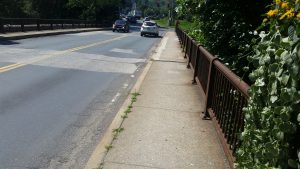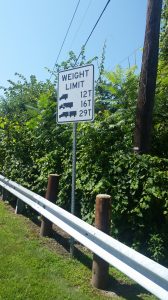WESTFIELD—In spite of pressure, The Massachusetts Department of Transportation (MassDOT) still has not made a determination on the waiver regarding the Westfield Fire Department’s use of Cowles Bridge along Southwick Road.
The Westfield Fire Department is still awaiting a determination from MassDOT for a waiver to allow certain vehicles to utilize the bridge. The waiver request was sent in early August, after the department received a request from MassDOT to not utilize the bridge, which is state-maintained, with vehicles that exceed the posted weight limits. Questions linger though, about when or if a waiver may be granted.
“We’re in a holding pattern, at the mercy of MassDOT,” Westfield Fire Chief Mary Regan said.
The request has prompted the department to not use most of their vehicles on Cowles Bridge. The vehicles that can still utilize the bridge because they are under the weight limit include the ambulances and rescue trucks.
The waiver, which Regan said was sent on Aug. 8, is still being evaluated by MassDOT, according to Patrick Marvin, spokesperson for MassDOT.
“We’re rating the bridge, that’s what happening right now,” he said, adding that there is no timeline for the results.
The initial timeline however, was about three weeks.
Meanwhile, Regan said that the department has been creative in attempting to lessen the impact of response times from not using the bridge by staffing at another fire station and utilizing different routes.
She said that about 35 calls have occurred where the department would normally utilize the bridge with their vehicles, with most of them being medical calls. During these calls, according to Regan, trucks have been delayed between 2 to 6 minutes.
During the medical calls an engine, which responds to medical calls to assist personnel on the ambulance, is not able to utilize the bridge, though the ambulance is able to cross and can start treatment.
“It’s getting frustrating but understand that we’re doing everything we can on our part to answer calls in that area in a timely manner,” she said.
Regan also said that the department has looked at the possibility of not receiving the waiver, and what sort of steps should be taken then, which could include the acquisition and use of a mini pumper, a type of vehicle that can be used in fire suppression.
According to Rep. John Velis, he is concerned with the uncertainty surrounding the waiver, as well as the potential impact delayed responses from the fire department could have related to the bridge. He also said that he has been a “thorn in the side” while attempting to get the issue resolved.
“My concern right now is where are we on the waiver, I need my constituents to be safe. We need to know where we stand,” Velis said.
“We just don’t know what’s going to happen. Give us something so we can plan accordingly,” he added.
“I’m not going to rest until we know the fate of this waiver. Squeaky wheel gets the oil,” he said.
Bridge safety and repairs
In addition to concerns about the Westfield Fire Department being able to utilize the bridge, concerns have come out about the overall safety of the bridge, as well as possible funding for the bridge’s repairs.
Marvin said via email that the bridge was initially load-restricted in 1992 “as it was structurally deficient due to the condition of the ends of some of its arches.” However, he said repairs were made in 1995 and the restriction stayed “to optimize the bridge’s longevity.”
The bridge continued to be in at least fair condition, according to Marvin, until 2010, when it was determined that there were areas that were structurally deficient.
According to Marvin via email, the bridge’s deck, substructure and superstructure are rated, according to the last bridge inspection, at a “4” on a 0 to 10 scale, with 0 being in the worst condition and 10 being the highest. The score of 4 indicates the above mentioned areas as deficient, he wrote.
Marvin wrote via email, “It’s important to note that a deficiency rating does not mean the bridge is unsafe, but indicates there is a level of deterioration that requires further attention of bridge personnel or increased monitoring.
“Similarly, a load restriction only means that overweight vehicles should not utilize the bridge as the bridge’s condition and longevity are optimized by lighter vehicles.”
Marvin also said that “MassDOT is committed to maintaining a safe and reliable transportation system and would take action such as closing or further restricting this bridge if it identified any immediate safety issues.”
Regarding repairs, Marvin said via email that the bridge is “programmed into the MassDOT bridge replacement program and is expected to be replaced in the coming years.”
The bridge is currently planned for the Fiscal Year 2020 in the State Transportation Improvement Program (STIP).
And regarding possible funding of repairs on the bridge through Chapter 90 funding given to the city from the state annually for reimbursement of certain road-related projects approved by MassDOT, City Engineer Mark Cressotti said that due to the bridge being under the purview of the state this could not be done.
“Chapter 90 funds are for our own facilities, our own roads. It’s state aid coming to the city,” he said. “We would be applying it to our responsibilities, not the state’s.”
In the instance of projects like the Great River Bridge, Cressotti said that the bridge itself was funded by the state, while the road on either side and traffic problems were municipal responsibility.
“Generally, if it’s a state bridge the state pays for it,” Cressotti said.




